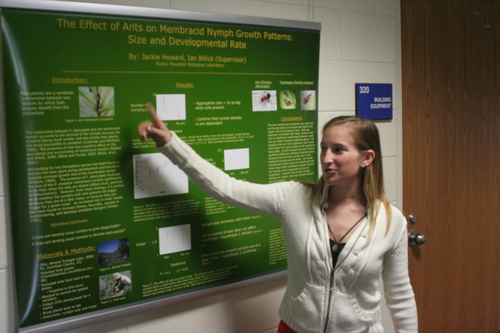The Annual Biology Department Diebold Symposium is normally held from Thursday to Saturday during 5th or 6th week of spring quarter. The Diebold Symposium provides an opportunity for each senior biology major to present publicly the results of his/her SIP experience, regardless of the discipline in which the SIP was done. The presentation will also be evaluated by the Department faculty, and will serve as one of the components of the grade for BIOL 490.
To assist the presenter in preparing a short, clear, polished report, the Biology Department has instituted a referee system. Junior biology majors participate as members of a referee team to help seniors prepare their presentations. Seniors act as peer advisors to fellow seniors, and work with their referee and advisory teams to prepare their presentations. Because the referees will be spending time with, and actively participating in, the preparation of the seminar or poster, these are graded positions, with the referee receiving the same grade as the presenter. To clarify faculty expectations of the seminar/poster and the role of the referees, the following guidelines are provided. At all times, however, it should be remembered that the ultimate responsibility for the presentation and the preparation is that of the presenter.
Guidelines for Oral Presentations
- Talks will start every 12 minutes. The actual presentation should be no longer than 10 minutes and follow with a 2 minute question period. The referees should time the talk and suggest ways of fitting what needs to be said into the allotted time frame.
- The seminar should be presented in much the same way a paper is written. The introduction is exceptionally important because, if the audience does not clearly understand the objectives of your project, it will difficult for them to follow the rest of the talk. The methodology should be limited to only that which is important in understanding the data presented in the talk. Do not present all of your raw data or all the data you collected unless it is itself directly important to illustrate your objectives and conclusions. Also, be sure that any graphs, tables, charts, etc. are easily visualized and not too busy (i.e., containing too much to be readily scanned). The referees can be invaluable here. As individuals not heavily invested in the project, they can determine if the report is clear and coherent and whether visual aids are useful. The referees should challenge the speaker when they do not understand what is said and assist in clarifying ideas and weeding out unnecessary material.
- The referees should be familiar enough with the presentation so that they can initiate discussion.
- The speaker should be introduced by one of the referees.
- Referees and timekeepers are responsible for making sure room lights are operated according to the needs of the speaker, and that the computer and/or slide projector is functioning properly.
- Timekeepers will make sure the speaker does not exceed the 12 minute time limit.
Guidelines for Poster Presentations

A poster presentation should be approachable at three levels: (1) a title and organization that inform the casual passerby of the general nature of your work; (2) a presentation method that would let a somewhat interested observer know the trends of your data and the nature of your conclusions; and (3) enough information to convince an individual working in the same area to stop and find out more about your project (i.e., engage in conversation with the presenter). Remember, the major role of a poster, or of any presentation, is to communicate your results and ideas to the audience.
Technical guidelines for making and printing posters are available through Information Technology Services’ Center for New Media Design located in Upjohn Library.
- Poster dimensions are 36 inches by 48 inches (posters may be formatted in portrait or landscape orientation but follow margin guidelines provided by the Center for New Media).
- The title should be displayed clearly across the top in large letters. Beneath the title, and in smaller letters, should be the name of the presenter, the name of the presenter’s mentor, and the institution or laboratory in which the work was done.
- Verbiage should be kept to a minimum. Written statements should be in large print, which is easily readable from a distance of 3 to 4 feet.
- An abstract may be included, but space limitations may dictate that you concentrate on the more important components such as Introduction, Methods, etc.
- The Introduction should be moderately brief and to the point so that the reader becomes immediately aware of the purpose of the investigation. It probably should be confined to one paragraph, and should be located at the upper left of the poster.
- The Materials and Methods (or procedures) section should be labeled clearly as such, and should follow immediately after the Introduction. This section often lends itself to the diagrammatic presentation with a minimum of verbiage. Insofar as possible, easily followed flow diagrams should be used.
- Results are the most important part of the poster and generally should occupy the center of the exhibit. The results should consist of a maximum number of illustrations (i.e., graphs, photographs, etc.) which are simple and easy to read, and a minimum of verbiage. Color-coding graphs and figures facilitates ease of interpretation.
- Conclusions should be stated in a clear and especially concise fashion. Generally, this section would be located to the right of the results. Itemization (listing) of conclusions is legitimate and can facilitate comprehension. Discussion should be kept to a minimum and should include only the most important points.
- A reasonable number of figures included on a poster are six, but this depends on the subject matter being presented.
- For investigations consisting of separate components, the sequence in which the components are described in Materials and Methods should be maintained in the Results and Conclusions sections.
